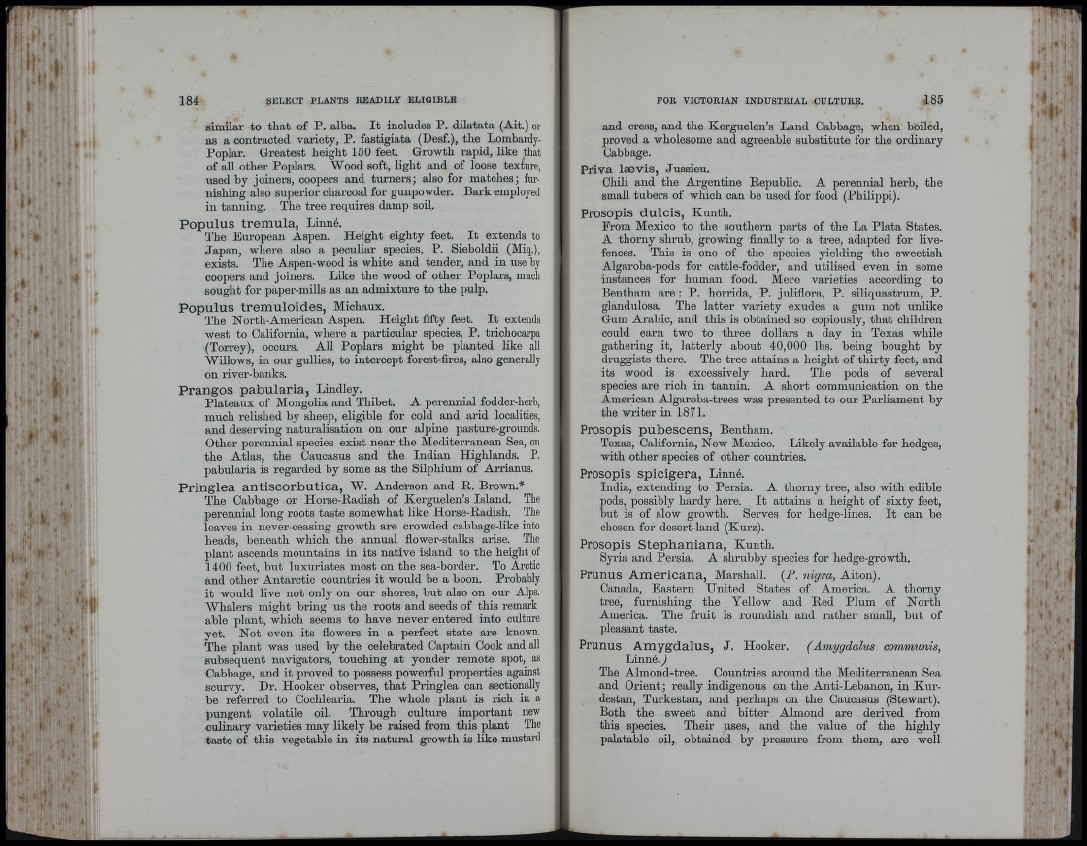
' G
I I
similar to th a t of P. alba. I t includes P. dilatata (Ait.) or
as a contracted variety, P. fastigiata (Desf.), the Lombardy-
Poplar. Greatest height 150 feet. Growth rapid, like that
of all other Poplam. Wood soft, light and of loose texture,
used by joiners, coopers and turners; also for matches; furnishing
also superior charcoal for gunpowder. Bark employed
in tanning. The tree requires damp soil.
Populus tremula, Linné.
The European Aspen. Height eighty feet. I t extends to
Japan, where also a peculiar species, P. Sieboldii (Miq.),
exists. The Aspen-wood is white and tender, and in use by
coopers and joiners. Like the wood of other Poplars, much
sought for paper-mills as an admixture to the pulp.
Populus tremuloides, Michaux.
The North-American Aspen. Height fifty feet. I t extends
west to California, where a particular species, P. trichocarpa
(Torrey), occurs. All Poplars might be planted like all
Willows, in our gullies, to intercept forest-fires, also generally
on river-banks.
Prangos pabularia, Lindley.
Plateaux of Mongolia and Thibet. A perennial fodder-herb,
much relished by sheep, eligible for cold and arid localities,
and deserving naturalisation on our alpine pasture-grounds.
Other perennial species exist near the Mediterranean Sea, on
the Atlas, the Caucasus and the Indian Highlands. P.
pabularia is regarded by some as the Silphium of Arrianus.
Pringlea antiscorbutica, W. Anderson and E. Brown.*
The Cabbage or Horse-Badish of Kerguelen’s Island. Tbe
perennial long roots taste somewhat like Horse-Badish. Tbe
leaves in never-ceasing growth are crowded cabbage-like into
heads, beneath which the annual fiower-stalks arise. The
plant ascends mountains in its native island to the height of
1400 feet, but luxuriates most on the sea-border. To Arctic
and other Antarctic countries it would be a boon. Probably
it would live not only on our shores, but also on our Alps.
Whalers might bring us tbe roots and seeds of this remark
able plant, which seems to have never entered into culture
yet. Not even its flowers in a perfect state are known,
Tbe plant was used by the celebrated Captain Cook and all
subsequent navigators, touching at yonder remote spot, as
Cabbage, and it proved to possess powerful properties against
scurvy. Dr. Hooker observes, th a t Pringlea can sectionally
be referred to Cochlearia. The whole plant is rich in a
pungent volatile oil. Through culture important new
culinary varieties may likely be raised from this plant The
taste of this vegetable in its natural growth is like mustard
and cress, and the Kerguelen’s Land Cabbage, when boiled,
proved a wholesome and agreeable substitute for the ordinary
Cabbage.
Priva lævis, Jussieu.
Chili and the Argentine Bepublic. A perennial herb, the
small tubers of which can be used for food (Pbilippi).
Prosopis dulcis, Kunth.
From Mexico to the southern parts of the La Plata States.
A thorny shrub, growing finally to a tree, adapted for live-
fences. This is one of the species yielding the sweetish
Algaroba-pods for cattle-fodder, and utilised even in some
instances for human food. Mere varieties according to
Bentham are : P. hórrida, P. juliflora, P. siliquastrum, P.
glandulosa. The latter variety exudes a gum not unlike
Gum Arabic, and this is obtained so copiously, that children
could earn two to three dollars a day in Texas while
gathering it, latterly about 40,000 lbs. being bought by
druggists there. The tree attains a height of thirty feet, and
its wood is excessively hard. The pods of several
species are rich in tannin. A short communication on the
American Algaroba-trees was presented to our Parliament by
the writer in 1871.
Prosopis pubescens, Bentham.
Texas, California, New Mexico. Likely available for hedges,
with other species of other countries.
Prosopis spicigera, Linné.
India, extending to Persia. A thorny tree, also with edible
pods, possibly bardy here. I t attains a height of sixty feet,
but is of slow growth. Serves for bedge-lines. I t can be
chosen for desert-land (Kurz).
Prosopis Stephaniana, Kunth.
Syria and Persia. A shrubby species for hedge-growth.
Prunus Americana, Marshall. (P. nigra, Aiton).
Canada, Eastern United States of America. A thorny
tree, furnishing the Yellow and Bed Plum of North
America. The fruit is roundish and rather small, but of
pleasant taste.
Prunus AmygdaluSj J . Hooker. ( Amygdalus communis,
Linné. ^
The Almond-tree. Countries around the Mediterranean Sea
and Orient; really indigenous on the Anti-Lebanon, in Kur-
destan, Turkestan, and perhaps on the Caucasus (Stewart).
Both the sweet and bitter Almond are derived from
this species. Their uses, and the value of the highly
palatable oil, obtained by pressure from them, are well
! '
£V; W
-il 'I ^
,L ,3 f
N'; ,
iH